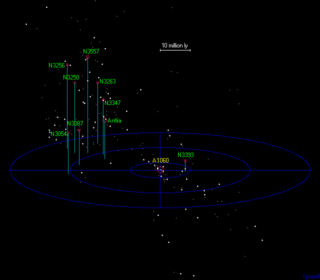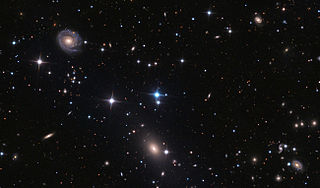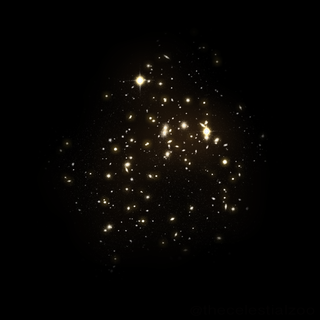Related Research Articles

Corona Borealis is a small constellation in the Northern Celestial Hemisphere. It is one of the 48 constellations listed by the 2nd-century astronomer Ptolemy, and remains one of the 88 modern constellations. Its brightest stars form a semicircular arc. Its Latin name, inspired by its shape, means "northern crown". In classical mythology Corona Borealis generally represented the crown given by the god Dionysus to the Cretan princess Ariadne and set by him in the heavens. Other cultures likened the pattern to a circle of elders, an eagle's nest, a bear's den, or even a smokehole. Ptolemy also listed a southern counterpart, Corona Australis, with a similar pattern.

A supercluster is a large group of smaller galaxy clusters or galaxy groups; it is among the largest known structures of the universe. The Milky Way is part of the Local Group galaxy group, which in turn is part of the Virgo Supercluster, which is part of the Laniakea Supercluster. The large size and low density of superclusters means that they, unlike clusters, expand with the Hubble expansion. The number of superclusters in the observable universe is estimated to be 10 million.

The Virgo Supercluster or the Local Supercluster is a mass concentration of galaxies containing the Virgo Cluster and Local Group, which in turn contains the Milky Way and Andromeda galaxies. At least 100 galaxy groups and clusters are located within its diameter of 33 megaparsecs. The Virgo SC is one of about 10 million superclusters in the observable universe and is in the Pisces–Cetus Supercluster Complex, a galaxy filament.

The Great Attractor is a gravitational anomaly in intergalactic space and the apparent central gravitational point of the Laniakea Supercluster. The observed anomalies suggest a localized concentration of mass millions of times more massive than the Milky Way. However, it is inconveniently obscured by our own Milky Way's galactic plane, lying behind the Zone of Avoidance (ZOA), so that, in visible light wavelengths, the Great Attractor is difficult to observe directly.

The Hydra-Centaurus Supercluster, or the Hydra and Centaurus Superclusters, is a supercluster in two parts, the closest neighbour of Virgo Supercluster.

The Hydra Cluster is a galaxy cluster that contains 157 bright galaxies, appearing in the constellation Hydra. The cluster spans about ten million light-years and has an unusually high proportion of dark matter. The cluster is part of the Hydra-Centaurus Supercluster located 158 million light-years from Earth. The cluster's largest galaxies are elliptical galaxies NGC 3309 and NGC 3311 and the spiral galaxy NGC 3312 all having a diameter of about 150,000 light-years. In spite of a nearly circular appearance on the sky, there is evidence in the galaxy velocities for a clumpy, three-dimensional distribution.

The Pavo-Indus Supercluster is a neighboring supercluster located about 60–70 Mpc (196–228 Mly) away in the constellations of Pavo, Indus, and Telescopium. The supercluster contains three main clusters, Abell 3656, Abell 3698, and Abell 3742.

The Antlia Cluster is a cluster of galaxies located in the Hydra-Centaurus Supercluster. The Antlia Cluster is the third-nearest to the Local Group after the Virgo Cluster and Fornax Cluster. Antlia's distance from Earth is 40.5 megaparsecs to 40.9 Mpc (133.4 Mly) and can be viewed from Earth in the constellation Antlia. The Antlia Cluster should not be confused with the Antlia Dwarf galaxy.
The Pisces–Cetus Supercluster Complex is a galaxy filament. It includes the Virgo Supercluster which in turn contains the Local Group, the galaxy cluster that includes the Milky Way. This filament is adjacent to the Perseus–Pegasus Filament.

The Hercules Superclusters refers to a set of two nearby superclusters of galaxies.

The Laniakea Supercluster, is the galaxy supercluster that is home to the Milky Way and approximately 100,000 other nearby galaxies. It was defined in September 2014, when a group of astronomers including R. Brent Tully of the University of Hawaii, Hélène Courtois of the University of Lyon, Yehuda Hoffman of the Hebrew University of Jerusalem, and Daniel Pomarède of CEA Université Paris-Saclay published a new way of defining superclusters according to the relative velocities of galaxies. The new definition of the local supercluster subsumes the prior defined local supercluster, the Virgo Supercluster, as an appendage.

NGC 6086 is an elliptical galaxy in the constellation of Corona Borealis. It has an apparent magnitude of 12.7. A Type-cD galaxy, it is the brightest cluster galaxy in the cluster Abell 2162. In 2010, a supermassive black hole was discovered in NGC 6086.

The Corona Borealis Supercluster is a supercluster located in the constellation Corona Borealis and the most prominent example of its kind in the Northern Celestial Hemisphere. Dense and compact compared with other superclusters, its mass has been calculated to lie somewhere between 0.6 and 12 × 1016 solar masses (M⊙). It contains the galaxy clusters Abell 2056, Abell 2061, Abell 2065 (the most massive galaxy cluster within the supercluster), Abell 2067, Abell 2079, Abell 2089, and Abell 2092. Of these, Abell 2056, 2061, 2065, 2067 and A2089 are gravitationally bound and in the process of collapsing to form a massive cluster. This entity has an estimated mass of around 1 × 1016 M⊙. If there is inter-cluster mass present, then Abell 2092 may also be involved. It has been estimated to be 100 megaparsecs (330 million light-years) wide and 40 megaparsecs (130 million light years) deep. It has a redshift of 0.07, which is equivalent to a distance of around 265.5 megaparsecs (964 million light-years).

Abell 2065 is a highly concentrated galaxy cluster in the constellation of Corona Borealis containing over 400 member galaxies, the brightest of which are 16th magnitude. The cluster is more than one billion light-years from Earth. On a larger scale still, Abell 2065, along with Abell 2061, Abell 2067, Abell 2079, Abell 2089, and Abell 2092, make up the Corona Borealis Supercluster.
Abell 2067 is a galaxy cluster in the constellation of Corona Borealis. On a larger scale, Abell 2067, along with Abell 2061, Abell 2065, Abell 2079, Abell 2089, and Abell 2092, make up the Corona Borealis Supercluster. Abell 2061 lies 1.8 megaparsecs south of it and the two are likely interacting.
Abell 2162 is a galaxy cluster in the Abell catalogue located in the constellation Corona Borealis. It is a member of the Hercules Superclusters, the redshifts of the member galaxies of which lie between 0.0304 and 0.0414. The cluster hosts a massive Type-cD galaxy called NGC 6086.

NGC 6120 is a peculiar spiral galaxy located roughly 440 million light-years away from the Sun. It is located in the northern constellation of Corona Borealis, and is a member of the Abell 2199 galaxy cluster.
Perseus–Pegasus Filament is a galaxy filament containing the Perseus-Pisces Supercluster and stretching for roughly a billion light years. Currently, it is considered to be one of the largest known structures in the universe. This filament is adjacent to the Pisces–Cetus Supercluster Complex.
References
- 1 2 3 van Weeren, R. J.; Brüggen, M.; Röttgering, H. J. A.; Hoeft, M.; Nuza, S. E.; Intema, H. T. (2011). "Radio continuum observations of new radio halos and relics from the NVSS and WENSS surveys. Relic orientations, cluster X-ray luminosity, and redshift distributions". Astronomy & Astrophysics. 533 (A35): 20. arXiv: 1107.5597 . Bibcode:2011A&A...533A..35V. doi:10.1051/0004-6361/201117149. S2CID 55747728.
- ↑ Postman, M.; Geller, M. J.; Huchra, J. P. (1988). "The dynamics of the Corona Borealis supercluster". Astronomical Journal. 95: 267–83. Bibcode:1988AJ.....95..267P. doi:10.1086/114635.